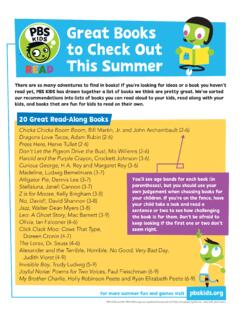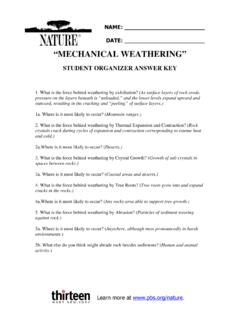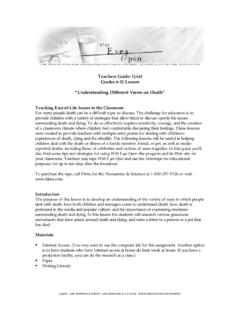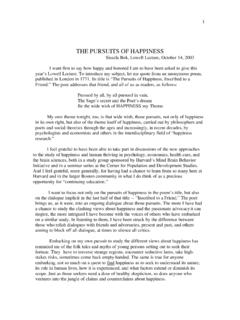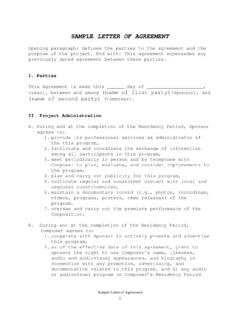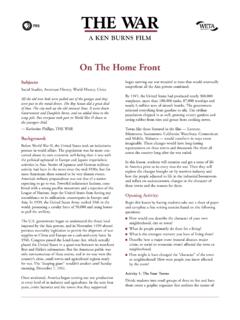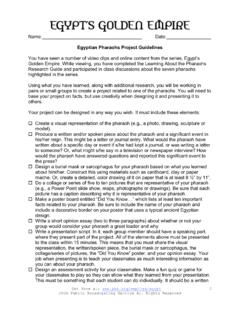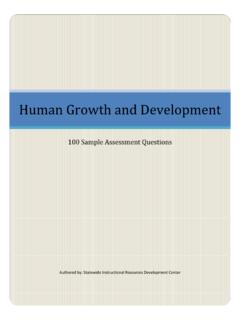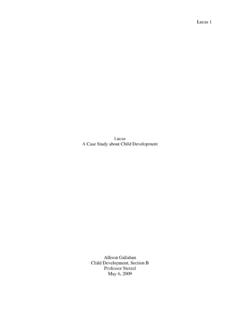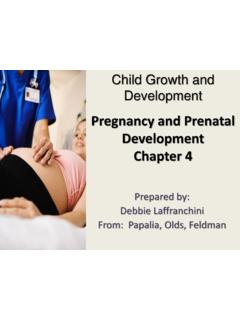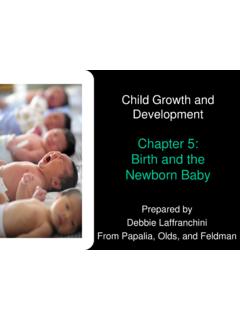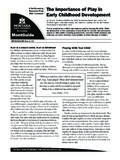Transcription of Lesson Title: The Developing Child - PBS
1 1 Lesson Title: The Developing Child Grade Levels: 9-12 Time Allotment: Two 45-minute class periods Overview: In this Lesson , students learn about the changes that occur in children as they grow. In the Introductory Activity, students brainstorm and use online resources to explore the stages of development children go through from birth to age five. In the Learning Activity, students explore video segments from the PBS program The Human Spark to learn about brain growth , language development and how children s views of right and wrong can be shaped by others. In the Culminating Activity, students reflect upon their own process of development and how they acquired their skills and knowledge. Subject Matter: Science; Psychology; Child development Learning Objectives: Students will be able to: o Describe important Child development milestones from birth to age five.
2 O Discuss the Developing human brain. o Describe how the development of humans compares to that of animals and discuss the role of language in children s development . o Explain how authority figures can influence children s perceptions of right and wrong. o Discuss what has shaped their own skills and knowledge. Standards: National Standards for High School Psychology Curricula Standard Area IIIA: Lifespan development Content Standards After concluding this unit, students understand: CONTENT STANDARD IIIA-1: development as a lifelong process Students are able to (performance standards): o Describe physical, social, and cognitive changes from the prenatal period throughout the lifespan. Students may indicate this by (performance indicators): a. Illustrating developmental changes in physical, cognitive, and social development b.
3 Describing research on Child development ; c. Hypothesizing on the interaction of physical, cognitive, and/or social changes in behavior; d. Inferring how peer 2 relationships change over time; e. Describing similarities and differences in development across cultures; f. Discussing the relative importance of peers versus parents influence in different cultural groups; g. Examining the role of psychology in enhancing the life of older adults. o Identify the complex cognitive structures found in the early development of infants and young children. Students may indicate this by (performance indicators): a. Citing research on the capabilities of infants and young children; b. Comparing contemporary research on early views of infant capabilities with current understanding; c.
4 Discussing the role of the caregiver in promoting Child development ; d. Explaining how cultural practices in Child -rearing may influence cognitive development . o Apply lifespan principles to personal experience. Students may indicate this by (performance indicators): a. Comparing their own life experiences with general patterns of others from their generation; b. Predicting their own developmental changes over time; c. Describing transition from childhood to adolescence; d. Explaining the transition from adolescence to adulthood; e. Projecting themselves into late life adulthood ( , post 65) CONTENT STANDARD IIIA-4: Issues surrounding the developmental process (nature/nurture, continuity/discontinuity, stability/instability, critical periods) Students are able to (performance standards): o Describe the role of critical periods in development .
5 Students may indicate this by (performance indicators): a. Giving an example of a critical period in development ; b. Evaluating significance of critical periods in development ; c. Explaining difficulties of research in the area of critical periods; d. Linking cortical development to enriched environments during critical periods. o Explain the issues of continuity/discontinuity and stability/instability in development . Students may indicate this by (performance indicators): a. Giving an example to illustrate continuity or discontinuity in development ; b. Citing research concerning stability or instability of traits over time; New York State Standards: Learning Standards for Health, Physical Education, and Family and Consumer Sciences Students will know the basic principles of home and community safety.
6 They can demonstrate the skills necessary to maintain their homes and workplaces in a safe and 3 comfortable condition. They can provide a safe and nurturing environment for themselves and others. o Students understand the stages of Child development and apply this knowledge to activities designed to enrich the physical, social, mental, and emotional development of a young Child . This is evident, for example, when students: plan a daily program of balanced activity for preschoolers based on knowledge and understanding of patterns of Child growth and development ; describe effective ways of promoting positive behavior in children; identify characteristics of a safe and nurturing home and work environment. Media Resources The Human Spark, selected segments The Developing Brain A look at how the human brain develops throughout a person s life.
7 Language development An overview of how human language develops. Learning Right and Wrong A look at how a Child s views of what is right and wrong can be shaped by others. Websites: Child development and Parenting This section of the CDC s National Center on Birth Defects and Developmental Disabilities Website provides information about Child development , including the following: o The Milestones Quiz ( ) This interactive quiz highlights developmental milestones. o Developmental Milestones ( ) This section has fact sheets about developmental milestones from birth through age five. o Milestones Chart ( ) This interactive chart provides details about developmental milestones through age five. development Timeline This site features a Child development timeline, which students can use in the Introductory Activity.
8 4 Materials For the class: Computers with internet access Computer, projection screen and speakers (for class viewing of online/downloaded video segments) Child development Milestones handout. Optional. (See Before the Lesson for details.) Printouts of the following Important Milestones fact sheets from the CDC website. (Note: Print out enough copies so that each group of 2-3 students has one of the seven fact sheets. If possible, when conducting this Lesson s Introductory Activity, divide the class into at least seven groups before assigning these fact sheets so that each of the fact sheets can be distributed to at least one group. For example, at least one group should receive the end of 3 months fact sheet, at least one should receive the end of 7 months fact sheet, etc.)
9 It is fine if more than one group gets the same fact sheet. Instead of making printouts, you can have students access the information directly on the Web.) Important Milestones Fact Sheets from : Important Milestones by the End of 3 Months Important Milestones by the end of 7 Months Important Milestones by the end of 1 Year (12 Months) Important Milestones by the End of 2 Years (24 Months) Important Milestones by the End of 3 Years (36 months) Important Milestones by the End of 4 Years (48 months) Important Milestones by the End of 5 Years (60 months) Before the Lesson Prior to teaching this Lesson , you will need to: Optional: Print out the Child development Milestones handout and cut out each item along the dashed lines. Make enough copies so that each pair of students has at least one item on the sheet.
10 (There are 33 items on the sheet.) This handout can be used in the Introductory Activity. Print out the Important Milestones fact sheets from the CDC website. (See the Materials section for details.) Print out enough so that each group of 2-3 students has one fact sheet. 5 Note: Instead of printing out the sheets, you can have students access this information on the Web. Create a timeline in the classroom with the following points marked off: Birth 3 months 7 months 1 year 2 years 3 years 4 years 5 years Leave enough space between each of the points on the timeline, so that students can affix their Child development Milestones strips of paper in the appropriate spots. Preview all of the video segments and websites used in the Lesson .
